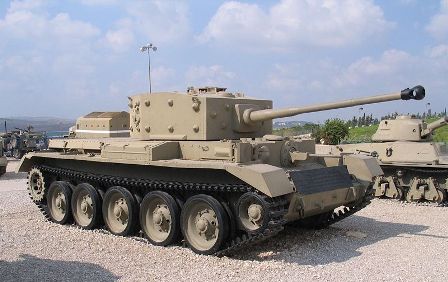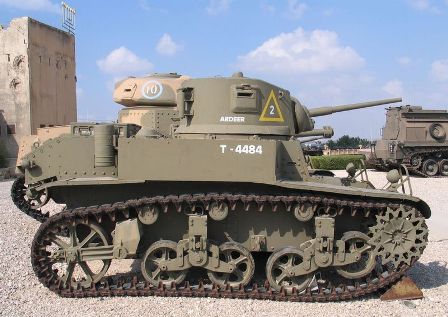
The light tank M3 Stuart entered full-scale production in 1941, and nearly 6000 were built. Many were passed to tbe Soviet Red Army and to British forces where they were known as crews, being used in all theatres of the war. Obsolete as a combat tank by 1944, many were converted to command and reconnaissance vehicles with the turrets removed and extra machine guns added instead. Variants included mine-clearing, flame-throwing and anti-aircraft versions.
Crew: 4
Weight: 12,927kg
Range: 112.8km
Armour: 15-43mm
Armament: one 37mm gun; two 7.7mm machine guns
Soviet Union Heavy Tank - T35

The T35 is unique, in that is the only five turreted tank to enter serial production. It's role was to break through enemy strongpoints. The main turret was armed with a short barrelled 76.2mm gun, and also three DT machine guns. The two medium sized turrets were armed with 45mm anti tank guns, and a DT machine gun each. The two small turrets housed a single DT machine gun each.
Crew: 11
Weight: 50,000kg
Range: 150km
Armor: 11-30mm
Armament: one 76.2mm gun; two 45mm anti tank guns; five or six 7.62mm machine guns
German Tank - Sturmpanzerwagen A7V
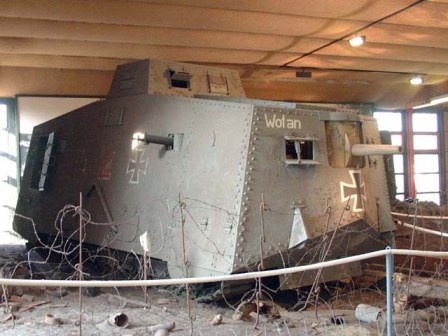
Following the appearance of the first British tanks on the Western Front in World War I , the first German tank - A7V was first used in combat on 21 March 1918 . It was deployed north of the St. Quentin Canal . The A7Vs helped stop a minor British breakthrough in the area.
On April 24th, 1918, the A7V took part in the first known tank-versus-tank engagement against three British Mk IV tanks (only one being of the "male" type however). The end result was two damaged of the "female" tanks with only one damaged A7V.
Crew: 16
Weight: 32,000kg
Range: 468km
Armor: 18-30mm
Armament: one 57mm gun; four 7.92mm machine guns
British Tank - Mark I Male
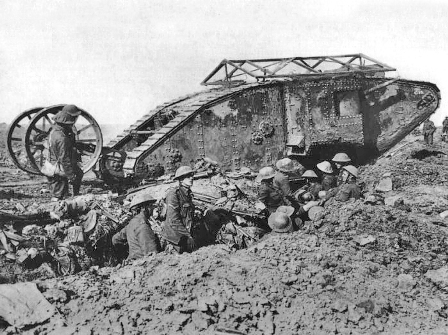
The Mk I was produced in 1916 and the design was what one might consider typical of World War One tracked systems.
It was the first tank used in the battle field of the World War I. Armament for the Mk I consists of two 6-pounder cannons. Four Hotchkiss .30 caliber machine guns were also offered for self-defense. A wire mesh assembly was fitted to the top of the tank in an effort to deflect oncoming enemy grenades.
the Mk I was an effective tool for ground forces as the design could easily navigate over the trenches dotting the battlefields.
Crew: 8
Weight: 28,000kg
Armor: 6-12mm
Armament: two 6-pounder guns; four 8mm machine guns
Soviet Union Tank - T-34/76
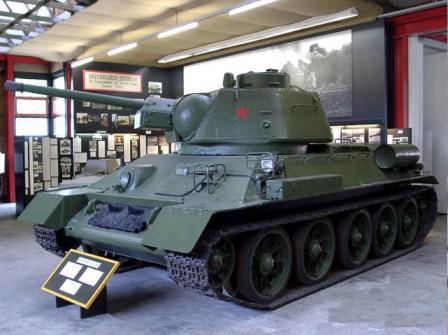
The T-34 was a Soviet medium tank produced since 1940. It is widely regarded as having been the world's best tank when the Soviet Union became involved in World War II, and although its armour and armament were surpassed by later tanks of the era, it has been often credited as the war's most effective, efficient and influential design. By the end of 1945, over 57,000 T-34s had been built: 34,780 original T-34 tanks in 1940–44, and another 22,559 T-34-85s in 1944–45.
The appearance of the T-34 in summer 1941 was a psychological shock to German soldiers, who had been prepared to face an inferior Soviet enemy. During the winter of 1941–42 the T-34 again dominated German tanks through its ability to move over deep mud or snow without bogging down; German tanks could not move over terrain the T-34 could handle. The Panzer IV used an inferior leaf-spring suspension and narrow track, and tended to sink in deep mud or snow.
Crew: 4
Weight: 28,500kg
Armor: 20-65mm
Armament: 76mm gun; 7.62mm machine gun
German Sturmpanzer IV - Brummbar
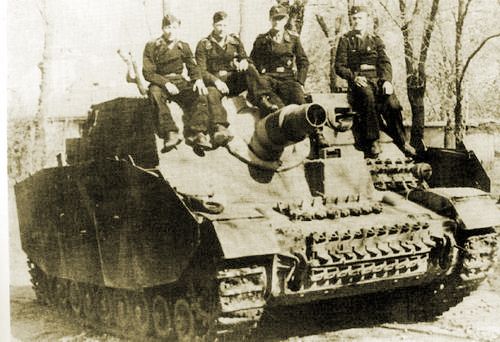
The Sturmpanzer IV was an armoured infantry support gun based on the Panzer IV chassis used in the Second World War. It was used at the Battles of Kursk, Anzio, Normandy, and helped to put down the Warsaw Uprising. It was known by the nickname Brummbär (German: "Grumbler") by Allied intelligence, a name which was not used by the Germans. German soldiers nicknamed it the "Stupa",a contraction of the term Sturmpanzer.
The Sturmpanzer IV was a development of the Panzer IV tank designed to provide direct infantry fire support, especially in urban areas. The result was the Sturmpanzer IV, which used a Panzer IV chassis with the upper hull and turret replaced by a new casemate-style armored superstructure housing a new gun, the 15 centimetres (5.9 in) Sturmhaubitze (StuH) 43 L/12 developed by Skoda. It fired the same shells as the 15 cm sIG 33 heavy infantry gun.
Production of the first series of 60 vehicles began in April 1943. 52 of these were built using new Panzer IV Ausf. G chassis and the remaining 8 from rebuilt Ausf. E and F chassis. Survivors, about half, were rebuilt beginning in December 1943 were mostly rebuilt to 2nd series standards.
Crew: 5
Weight: 28,200kg
Armor: front 100mm
Armament: 150mm heavy infantry gun; two 7.92mm machine gun
American Heavy Tank - M26 Pershing
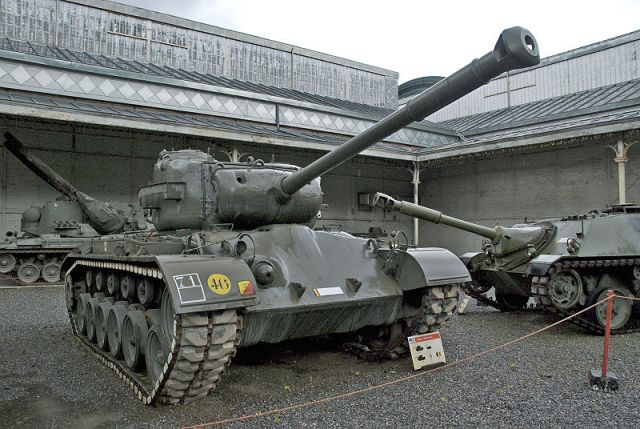
The M26 was a long time in development and only just reached combat status during WW2. A small number were brought across to Europe under the Zebra Technical Mission which included tanks, spares and military and civilian observers. They were assigned to General Omar Bradley's 12th Army Group and split between the 3rd and 9th Armored Division. They first saw combat in February 1945. Ten Pershing tanks were assigned to the 9th Armored Division, which was among the first to reach the Rhine river as American forces surged toward Germany. With American armor fast approaching, Nazi war planners sought to thwart - or at least delay - the advance by dynamiting major bridges spanning the river. When forward elements of the 9th Armored Division discovered that the Ludendorff Bridge at Remagen was still passable, they knew they would need to act quickly and decisively. On March 7, 1945, the 9th Armored arrived at the bridge, securing it as a strategic foothold across the Rhine. Of the ten Pershing tanks assigned to the 9th Armored, three made it to the bridge.
Crew: 5
Weight: 41,700kg
Armor: 25 - 110mm
Armament: 90mm gun; two 7.62mm Browning machine gun, one 12.7mm Browning heavy machine gun
Speed: 40km/h
Soviet Union Heavy Tank - SMK
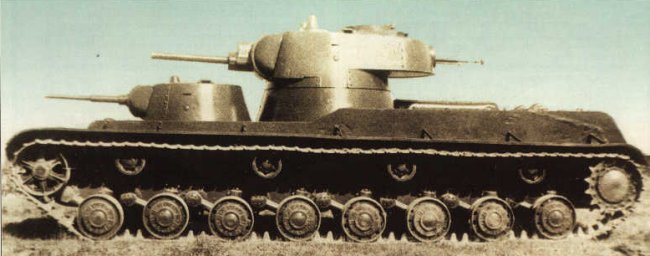
SMK (Sergius Mironovitch Kirov) was an armored vehicle (tank, AFV or armoured fighting vehicle) prototype developed prior to the Second World War (World War II or WWII). The SMK was a fully tracked all-terrain vehicle designed for military operations. SMK, also known to German intelligence as the T-35C, was designed by the Red Army of the Soviet Union (USSR).
The SMK was among the designs competing to replace the unreliable and expensive T-35. The testing ground for the SMK and other competing models, which included the KV-1, was the Winter War. The KV-1 design was chosen due to its resistance against Finnish anti-tank weapons.
Crew: 7
Weight: 55,000kg
Armor: 20 - 60mm
Armament: 45mm gun (front), 76.2mm gun (rear), three 7.62mm machine gun
Speed: 35km/h
German Half-track - Maultier (SdKfz 3)
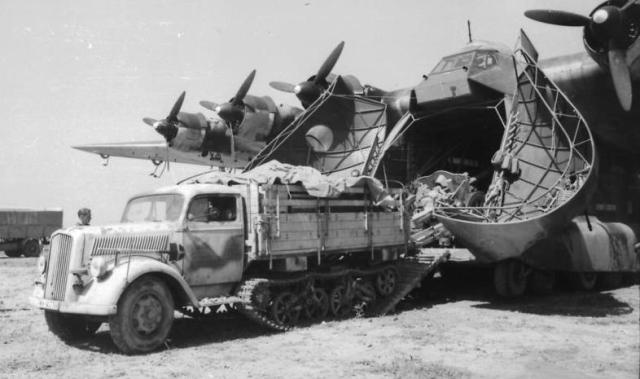
In the autumn of 1941 upon arrival on the Eastern Front the German army faced a problem about which nobody had given proper consideration during the planning for Operation Barbarossa - the absence of normal hardened roads in Russia. In the spring of 1942, when it became clear that war had settled in for the long term, and the problem would return with new force, it was decided to construct special semi-caterpillar versions of the standard models of truck. The Opel firm developed their own suspension bracket, more simple and technologically advanced in construction. Nevertheless, a uniform standard design was selected, a Ford suspension bracket which near-copied Carden Lloyd. The truck with caterpillar tracks instead of a back wheel pair received the name “Maultier” (”donkey”). The official name Opel Blitz Opel 3.6-36S/SSM Gleisketten-Lastkraftwagen did not achieve common use, and semi-caterpillars have for ever remained “Maultier”.
The Maultier was widely employed everywhere in all theaters of operations on the Eastern Front, but in 1944 when the German armies were forced back from the borders of the USSR, their role was considerably reduced - in the territories of Europe there were generally good road conditions during the war years. The numbers of Opel Maultiers substantially declined - new machines were not built, and during repair many Maultiers were converted back to conventionally wheeled vehicles. The Maultier was also used as a platform of AA gun and carry the Flak 38 20mm gun.
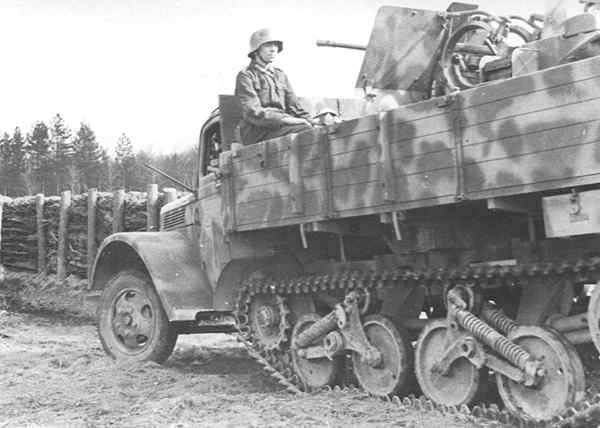
Crew: 3
Weight: 6,600kg
Power: 68hp
Speed: 38km/h
Armament: AA gun version with 20mm (Flak 38) gun
French Somua S35 Cavalry Tank
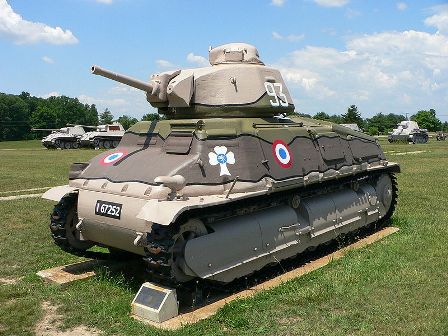
The SOMUA S35 was a French cavalry tank of the Second World War. Built from 1936 until 1940 to equip the armoured divisions of the Cavalry, it was for its time a relatively agile medium-weight tank, superior in armour and armament to both its French and foreign competitors, like the contemporary versions of the German Panzerkampfwagen III. It was constructed from well-sloped, mainly cast, armour sections, that however made it expensive to produce and time-consuming to maintain. During the German invasion of May 1940, the SOMUA S35 proved itself to be a tactically effective type, but this was negated by strategic mistakes in deploying its units. After the defeat of France in June 1940, limiting production to a number of 430, captured SOMUA S35s were used by the Axis powers. A derived type, the mostly welded SOMUA S40, with an improved engine, suspension, armour and armament, had been planned to replace the original version on the production lines in July 1940.
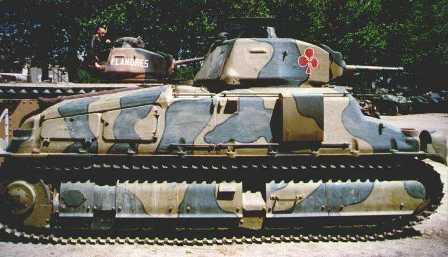
Crew: 3
Weight: 19,500kg
Armor: 47mm
Speed: 40km/h
Armament: 47mm SA 35 gun
German Half-track Troop Carrier - SdKfz 250/1

The vehicle was used in a wide variety of roles throughout World War II. The basic troop carrier version was used as an armored personnel carrier for reconnaissance units, carrying scout sections. This basic variant usually mounted one or two MG34 machineguns. Later variants carried 20mm, 37mm, and even 75mm guns to support the more lightly-armed versions.
The initial design had an armoured body made of multi-faceted plates which gave good protection against small arms fire, but which made the design both expensive to manufacture and quite cramped. Production of this early version stopped in October 1943 with some 4,200 built, and a second version, greatly simplified to speed up manufacture, began replacing it. In both variants, the armour was useful only for stopping small-arms fire and small artillery fragments. Heavy machinegun fire, anti-tank gun fire, or almost any tank gun could penetrate the Sd.Kfz. 250 at long range.
Crew: 2+4
Weight: 5,800kg
Armor: 5.5-14.5mm
Speed: 76km/h
Armament: 7.92mm MG34 machine gun
German Marder I - SdKfz 135
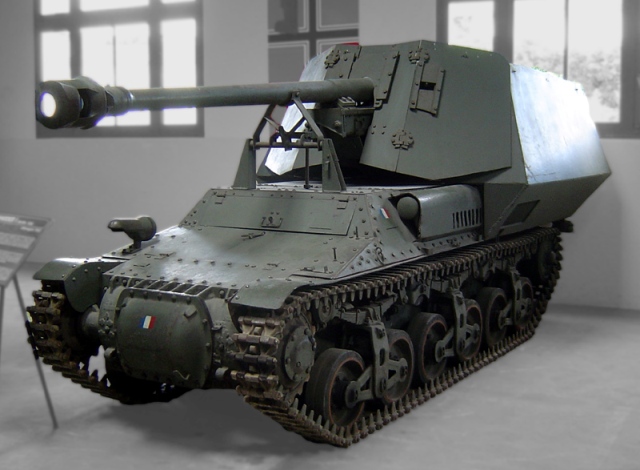
The Marder I was developed in May 1942 and carried the 75 mm PaK 40 anti-tank gun, on a Lorraine chassis. The original crew compartment superstructure was removed and the gun placed on top of the chassis. Around this a new, open-topped compartment was built, to give the gun and crew some protection from small arms fire.
Between July and August 1942, 170 Marder I's were built on the Lorraine chassis. Several other French and Polish tanks were also used as a conversion base for the Marder I, including the Hotchkiss H39 and FCM 36, though these were only built in small numbers.
Crew: 4 to 5
Weight: 8,200kg
Armament: 75mm PAK 40
Speed: 38km/h
German Marder II - SdKfz 132
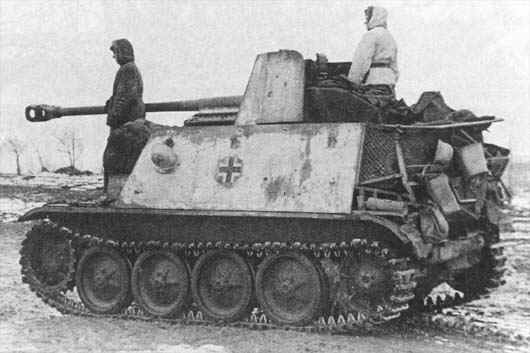
The Marder II came in two major versions. The first version Marder II (Sd.Kfz. 132) was based on the light Panzer II Ausf. D/E and Flammpanzer II chassis with Christie suspension. It was armed with captured Soviet 7.62 cm guns, re-chambered to accept German 7.5 cm Pak 40 ammunition, which improved its penetrative capablities. These early Marder IIs had a very high silhouette (2.60 m high), thin armor of only 30 mm (front) and 10 to 15 mm (sides). There was no armour on the top or rear, leaving the crew with very little protection. Alkett and Wegmann produced 201 Marder II (Sd. Kfz. 132) from early 1942 to early 1943.
Crew: 3
Weight: 10,800kg
Armament: 76.2mm Anti-tank Gun
Speed: 40km/h
German Marder III - SdKfz 139
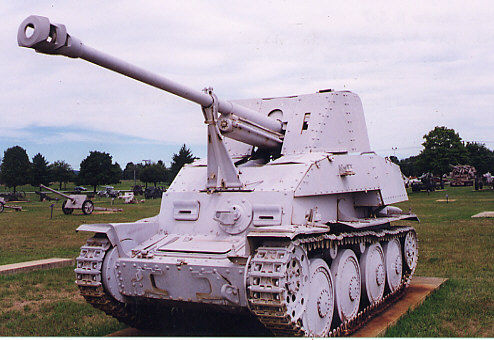
While the Panzer 38(t) had largely become obsolete as a tank in early 1942, it was still an excellent platform for adaptation into a tank destroyer, among other roles. Since the Soviet 76.2 mm field gun was captured in large quantities, the decision was made to mate this gun to the Panzer 38(t).
To do so, the turret and upper superstructure of the Panzer 38 were removed and a new superstructure was bolted on to the chassis. The upper structure mounted the gun and an extended gun shield, giving very limited protection for the commander and the loader. Armour protection overall ranged from 10 to 50 mm. The gun, commander and loader were located on top of the engine deck. It had higher silhouette than Panzer 38, which made it more vulnerable to enemy fire.
The now-called 7.62 cm PaK 36(r) was rechambered to be able to use standard German 75 mm ammunition, of which 30 rounds could be carried inside the vehicle. Apart from the main gun, there was a 7.92 mm machine gun mounted in the hull.
This tank destroyer was put into production as the Panzerjäger 38(t) für 7.62 cm PaK 36(r), Sd.Kfz. 139. A total of 363 of this Marder III variant were built from April 1942 to 1943.
Crew: 4
Weight: 10,700kg
Armament: 76.2mm PAK 36r or 75mm PAK 40
German Marder III M - SdKfz 138
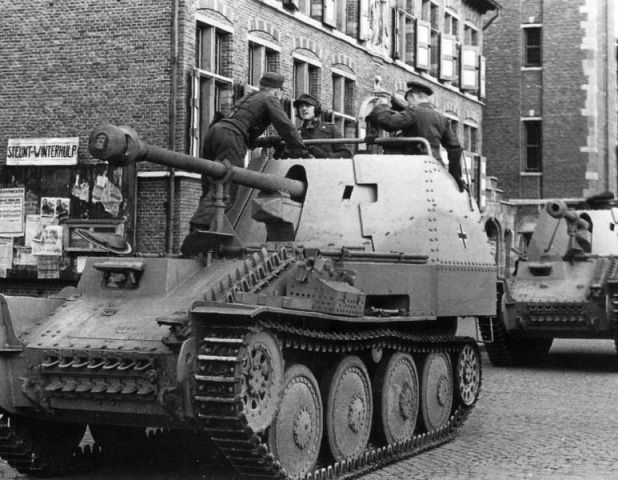
The last Marder III variant was based on the Panzer 38(t) Ausf. M (with Ausf. M standing for Mittelmotor (middle engine), again armed with the 75 mm PaK 40 anti-tank gun. In this variant, engine was moved from the rear to the middle between driver and the rest of crews. Because there was no engine in the rear, the gun and the crew did not have to sit on top of the engine deck like the previous models. The fighting compartment could be lowered down to the bottom floor level where the engine used to be. This decreased crew exposure, as well as visibility. Unlike the previous two Marder IIIs, fighting compartment was closed at the rear protecting the crew up to their mid-section. It stayed open-topped. It could only carry 27 rounds of ammunition. Machinegun port at the front was eliminated in Ausf. M, instead a MG 34 or MG 42 was carried by the crew. In previous two models, commander served as a gunner. However, in Ausf. M, radio man moved to the rear with commander and gunner, serving as a loader. Combat effectiveness increased because vehicle commander was freed from manning the gun.
The Ausf. M was the variant which was produced in the largest numbers, some 975 vehicles being manufactured in 1943 and early 1944. Its full name was the Panzerjäger 38(t) mit 7.5 cm PaK 40/3 Ausf.M, Sd.Kfz. 138.
Crew: 4
Weight: 10,500kg
Armament: 75mm PAK 40/3
British Infantry Tank - Valentine
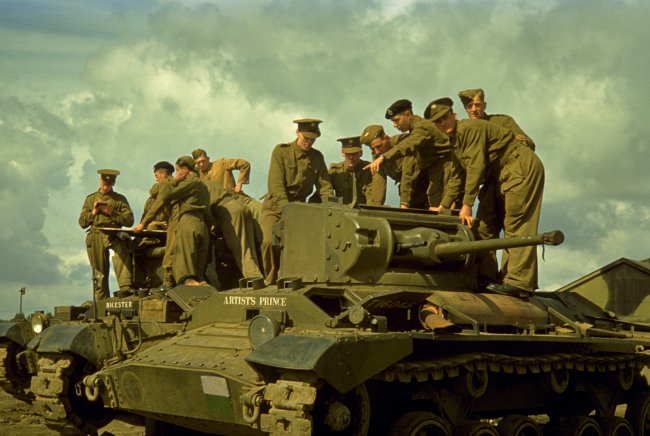
The Tank, Infantry, Mk III, Valentine was an infantry tank produced in the UK during the WW-II. More than 8,000 of the type were produced in 11 different marks plus various purpose-built variants, accounting for approximately a quarter of wartime British tank production. Over its lifetime it went from a riveted construction to entirely welded, and from a petrol powerplant to a safer, less ignitable, two stroke diesel engine produced by GMC. It was supplied to the USSR and built under license in Canada. Developed by Vickers, it proved to be both strong and reliable.
Based on the A10 Cruiser tank, the Valentine was privately designed by Vickers-Armstrongs (hence its lack of a General Staff "A" designation) and was submitted to the War Office on 10 February 1938. The development team tried to combine the weight of a cruiser tank with the greater armour of an infantry tank, which resulted in a very small vehicle with a cramped interior and two-man turret. Though its armour was still weaker than the Infantry Tank II Matilda and, due to a weaker engine, it shared the same top speed, the new design was easier to produce and much less expensive.
It finally approved the design in April, 1939. The vehicle reached trials in May, 1940, which coincided with the loss of nearly all of Britain's equipment during the evacuation at Dunkirk. The trials were successful and the vehicle was rushed into production as Infantry Tank III Valentine. The Valentine remained in production until April 1944, becoming Britain's most produced tank during the war with 6,855 units manufactured in the UK (by Vickers, Metropolitan-Cammell Carriage and Wagon and Birmingham Railway Carriage and Wagon), and a further 1,420 in Canada. They were the Commonwealth's main export to the Soviet Union under the Lend-lease Act, with 2,394 of the British models being sent and 1,388 of the Canadian Pacific built models, and the remaining 30 being kept for training.
Weight: 17,000kg
Armour: 8-65mm
Armament: 2-pounder gun
Speed: 24km/h
British Self-Propelled Artillery - Bishop
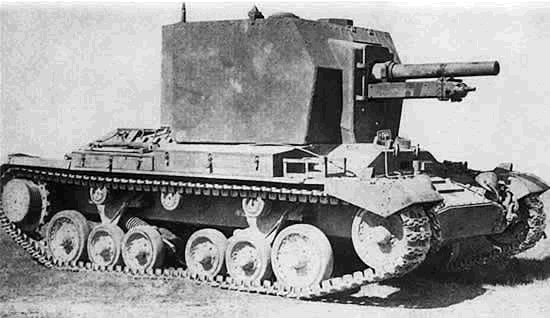
The Bishop was a British self-propelled artillery vehicle based on the Valentine tank. A result of a rushed attempt to create a self-propelled gun armed with the 25 Pounder gun-howitzer, the vehicle had numerous problems, was produced in limited numbers and was soon replaced by better designs.
The Bishop was based on the Valentine II hull, with the turret replaced by a fixed boxy superstructure with large rear doors. Into this superstructure the 25 pounder gun-howitzer was fitted. As a consequence of the gun mounting the resulting vehicle had very high silhouette, a disadvantage in desert warfare.[1] The maximum elevation for the gun was limited to 15 degrees, lowering the range considerably to about 6,400 yards (about half that of the gun on its wheeled carriage), the maximum depression was 5 degrees and traverse 8 degrees. In addition to the main armament the vehicle could carry a Bren light machine gun. By July 1942 80 Bishops had been built, and as the last 20 were being built an order for a further 50 was placed, with an option for a further 200, but the tender was abandoned in favour of the American M7 105 mm SP gun.
Crew: 4
Weight: 17,500kg
Armour: 8-60mm
Armament: 25-pounder gun
Speed: 24km/h
German Puma - SdKfz 234/2
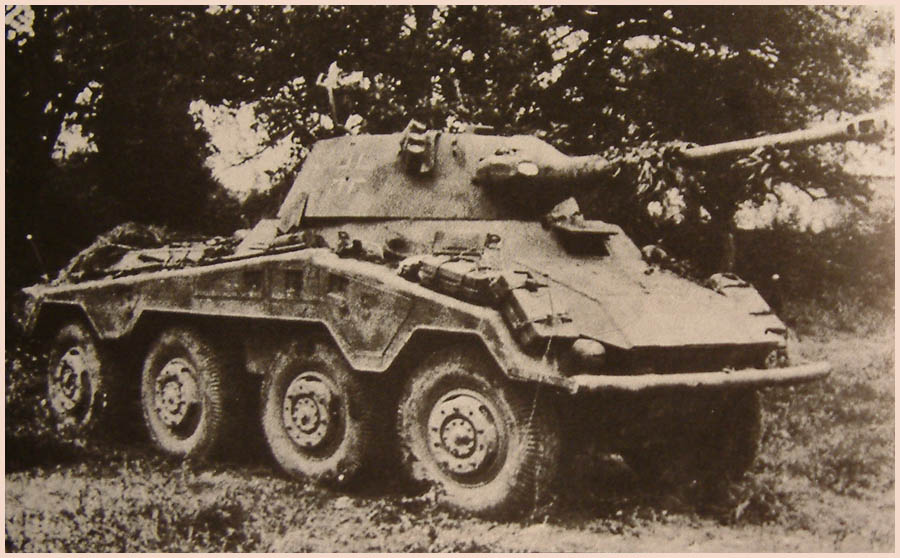
The SdKfz 234 (Sonderkraftfahrzeug 234, or special purpose vehicle 234) was an eight-wheeled armoured car used by the German Army in the Second World War.
The combat experience of the existing 8-wheeled armoured cars during the German invasions of Poland and France, indicated some deficiencies in the current design. Therefore, in August 1940 an improvement program was started, based on a new set of requirements learned from these combat experiences. The result was the SdKfz 234.
Developed from the Büssing-NAG SdKfz 232, design of the Sd Kfz 234 began in 1940. It was to have a monocoque chassis with eight wheels, like its predecessors, and an aircooled engine for use in North Africa.
Chassis were built by Büssing-NAG in Leipzig-Wahren, while armoured bodies were provided by Deutsche Edelstahlwerke of Krefeld and turrets by Daimler Benz in Berlin-Marienfeld and Schichau of Elbing, with engines from Ringhoffer-Tatra-Werke AG of Nesseldorf.
Crew: 4
Weight: 10,500kg
Armament: 50mm L/60 gun
German - SdKfz 222

The Leichter Panzerspähwagen (German: roughly "Light Armoured Reconnaissance Vehicle") were a series of light four-wheel drive armoured cars produced by Nazi Germany from 1935 to 1944.
They were developed by Eisenwerk Weserhütte of Bad Oeynhausen. Chassis were built by Auto Union in Zwickau and assembled by F. Schichau of Elbing and Maschinenfabrik Niedersachsen in Hanover-Linden.
It used the standard sPkw I Horch 801 (heavy car) chassis with an angled armoured body and turret.
The rear mounted engine was a 67 kW (90 hp) Horch 3.5 petrol engine, giving it a road speed of 80 km/h (50 mph) and a cross-country speed of 40 km/h (25 mph). It had a maximum range of 300 km (186 mi).
Used by the reconnaissance battalions (Aufklärungs-Abteilung) of the Panzer divisions, the type performed well enough in countries with good road networks, like those in Western Europe. However, on the Eastern Front and North Africa, this class of vehicle was hampered by its relatively poor off-road performance. In those theaters, it gradually found itself replaced in the reconnaissance role by the Sdkfz 250 half-track. The Sdkfz 250/9 was the Sdkfz 250 with the same turret as the Sdfkz 222.
This version of the vehicle was armed with a 2 cm KwK 30 L/55 autocannon and a 7.92 mm MG34 machine gun. The third crew member was the gunner, relieving the commander of that task. Some versions included a 28 mm armored piercing cannon. A prototype version included a 50 mm cannon. Two armored prototype versions were completed.
Crew: 3
Armour: 5-14.5mm
Armament: 20mm auto cannon
Italy M13/40 Medium Tank
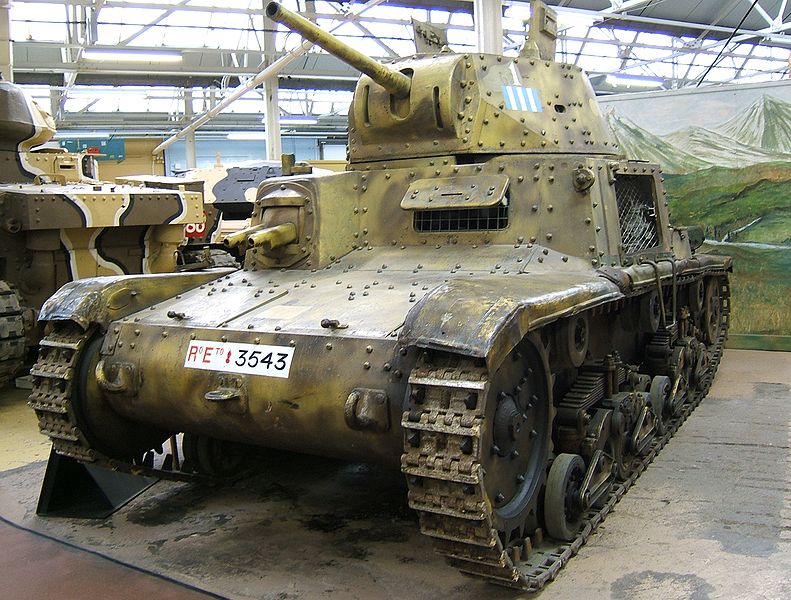
The Fiat-Ansaldo M13/40 was an Italian medium tank ("M" for (medium) according to the Italian tank weight standards at the time: 13 tonnes was the scheduled weight and 1940 the initial year of production), designed to replace the Fiat L3, the Fiat L6/40 and the Fiat M11/39 in the Italian Army at the start of World War II. The design was influenced by the British Vickers 6-Ton and was based on the modified chassis of the earlier Fiat M11/39. Indeed, M11/39 production was cut short in order to get the M13/40 into production. Although designated a medium tank, the M13/40 was closer to contemporary light tanks in armor and firepower.
Crew: 4
Armour: 42mm
Armament: 47mm cannon, 8mm machine gun
Speed: 32km/h
British AEC Matador Truck
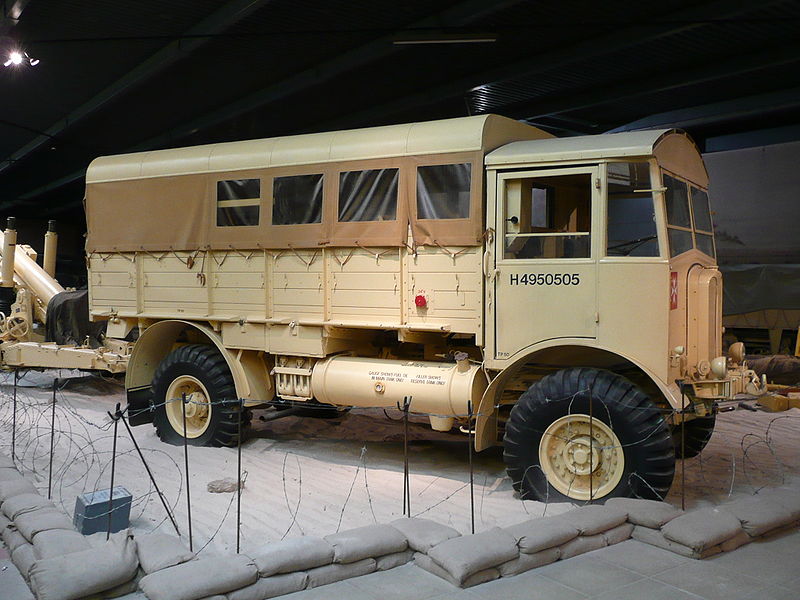
The AEC Matador was an artillery tractor built by the Associated Equipment Company for British and Commonwealth forces during the Second World War. AEC had already built a 4 x 2 lorry, also known as the Matador (all AEC lorries received 'M' names).
The Matador was distinctive with its flat fronted cab with gently curved roof, wheels at the corners and a flat load carrying area covered by a canvas or tarpaulin tilt. The cab was made from Ash and clad in steel. It was equipped with a winch (7-ton load in its case) like all artillery tractors. The O853 provided the basis for the 'Dorchester' Armoured Command Vehicle.
Crew: 1
Weight: 7.75 tons
Speed: 30mph
German Neubaufahrzeug Heavy Tank

The German Neubaufahrzeug series of tank prototypes were a first attempt to create a heavy tank for the Wehrmacht after Adolf Hitler had come to power. Multi-turreted, heavy and slow, they did not fit in with the Blitzkrieg tactics and therefore only five were made. These were primarily used for propaganda purposes, though three took part in the Battle of Norway in 1940.
Though these tanks were never placed in production, they provided a propaganda tool for Nazi Germany, for example being shown at the International Automobile Exposition in Berlin in 1939.
This propaganda role was extended with the German invasion of Norway, when a special Panzerabteilung was formed which took the three armored prototypes with them to Oslo. They saw some combat there, with one being blown up by German engineers when it got stuck in swamps near Åndalsnes. To replace it, one of the mild steel prototypes was used.
Crew: 6
Armament: 75mm KwK L/24 gun and 37mm KwK L/45
Speed: 25km/h
Soviet Union ZIS-5 Truck

The ZIS-5 (Russian: ЗиС-5) was a 4x2 Soviet truck produced by Moscow ZIS factory from October 1933 on. It was an almost identical copy of the American Autocar Model CA truck.
During the war the ZIS-5 was used on all fronts, where it was greatly appreciated for its remarkably simple and reliable construction. Apart for cargo duties, the ZIS-5 was used as a light artillery tractor and for troops transportation (25 soldiers could seat in five benches placed in the rear body). ZIS-5 served also as base for many special trucks, like refuellers, field workshops, ambulances, portee guns or AA platforms.
After the GAZ-AA, the ZIS-5 was the 2nd most used Red Army truck of 1933-1943 period. The intensive growth of Lend Lease trucks shipping in 1943-1944 did not affected the first line use of the "Tryohtonka" (as soldiers called the ZIS-5 for its 3-ton payload), while GAZ-AA got somewhat phased out to secondary roles.
The ZIS-5 showed remarkable service on the "Road of Life", the only supply line to the besieged city of Leningrad, opened on the frozen surface of the Ladoga Lake in the winter months during 1941–1944.
Crew: 1
Weight: 3.1 tons
Speed: 60km/h
USA Tank Destroyer - M18 Hellcat
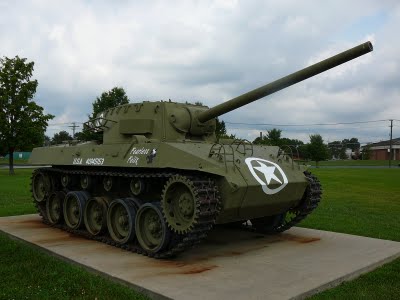
The 76 mm Gun Motor Carriage (GMC) M18 was an American tank destroyer of World War II. The manufacturer, Buick, gave it the nickname "Hellcat" and it was the fastest tracked armored fighting vehicle during the war with a top speed up to 60 mph.
The M18 served primarily in Western Europe, but was also present in the Pacific. However, due to the comparitive rarity and poor quality of Japanese armour it was often used in a fire support role instead of as a tank destroyer.
On September 19, 1944, in the Nancy Bridgehead near Arracourt, France, the 704th Tank Destroyer Battalion was attached to the 4th Armored Division. Lt. Edwin Leiper led one M18 platoon of C Company to Rechicourt-la-Petite, on the way to Moncourt. He saw a German tank gun muzzle appearing out of the fog 30 feet away, and deployed his platoon. In a five minute period, five German tanks of the 113 Panzer Brigade were knocked out for the loss of one M18. The platoon remained in their position and destroyed a further ten German tanks, with the loss of another two M18s. One of the platoon's M18s, commanded by Sgt Henry R. Hartman, knocked out six of these and lived to fight another day. Most of the German tanks were Panthers.
The M18 Hellcat was a key element during World War II in the Battle of the Bulge. On December 19 and 20, the 1st Battalion of the 506th PIR, was ordered to support Team Desobry, a battalion-sized tank-infantry task force of the 10th Armored Division (United States) assigned to defend Noville located north-northeast of both Foy and of Bastogne just 4.36 miles (7 km) away. With just four M18 tank destroyers of the 705th Tank Destroyer Battalion to assist, the paratroopers attacked units of the 2nd Panzer Division, whose mission was to proceed by secondary roads via Monaville (just northwest of Bastogne) to seize a key highway and capture, among other objectives, fuel dumps—for the lack of which the overall German counter-offensive faltered and failed. Worried about the threat to its left flank in Bastogne, it organized a major joint arms attack to seize Noville. Team Desobry's high speed highway journey to reach the blocking position is one of the few documented cases wherein the legendary top speed of the M18 Hellcat (55 miles per hour (89 km/h), faster than today's M1A2 Abrams) was actually used to get ahead of an enemy force as envisioned by its specifications.
The attack of 1st Battalion and the M18 Hellcat tank destroyers of the 705th TD Battalion near Noville together destroyed at least 30 German tanks and inflicted 500 to 1000 casualties on the attacking forces in what amounted to a spoiling attack. A Military Channel expert historian credited the M18 destroyers with 24 kills, including several Tiger tanks, and believes that, in part, their ability to "shoot and scoot" at high speed and then reappear elsewhere on the battlefield and therefore appear to be another vehicle entirely played a large part in confusing and slowing the German attack, which subsequently stalled, leaving the Americans in possession of the town overnight.
Crew: 5
Armor: 5 to 25mm
Armament: 76mm gun


